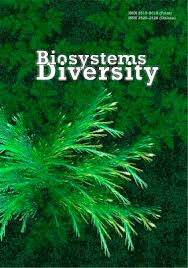Features of Trifolium rubens (Leguminosae) ontomorphogenesis in conditions of Ukraine
Features of Trifolium rubens (Leguminosae) ontomorphogenesis in conditions of Ukraine
Author(s): A. M. Gnatiuk, M. B. Gaponenko, A. М. GaponenkoSubject(s): Agriculture, Regional Geography, Environmental Geography
Published by: Дніпропетровський національний університет імені Олеся Гончара
Keywords: ruddy clover; ontogeny; rare plant; morphology; age stages;
Summary/Abstract: The necessary basis for studying the structure and dynamics of populations is an investigation of ontomophogenetic peculiarities and establishment of ontogenetic stages of individuals. Information about ontomorphogenesis is especially important for protected species of plants. The minimal amount of data on morphology of plants in the different periods of ontogenesis complicates plant identification and evaluation of population state conditions in nature and culture. Trifolium rubens L. is a perennial Central European plant listed in the Red Book of Ukraine as a rare species. The objective of this research is to analyze the peculiarities of ontomorphogenesis of T. rubens, to establish diagnostic signs of age stages and the sequence of their passage for identification of the multivariance of development. The results of the study on T. rubens ontomorphogeny at the M. M. Gryshko National Botanical Garden оf the National Academy of Sciences of Ukraine and in the natural population in Zakarpattya are represented in this article. The terms “age stage” and “age period” are used to describe the degree of ontogenetic development of individuals. Diagnostic features of the age periods: latent, pregenerative, generative and senile are established. Detailed morphological descriptions of plants in different stages of ontogenesis are presented. The study shows a multivariate development that reveals different sequences of passing ontogenesis stages by individuals and, accordingly, the rate of their aging and life expectancy. It was found that during the first year of vegetation the plants undergo two periods (latent and pregenerative) and 5 stages of ontogeny (latent, seedlings, juvenile, immature and virginile). The first bloom in plants appears mainly in the second year of vegetation. The research showed the change of the leaf blade shape in ontogeny from simple to compound. There is a difference in the pubescence of leaf parts, and leaf shape indicates that these features are age-old. It was concluded that the aboveground part of the immature, virginile, generative individuals during the flowering period of plants differ from subsenile and senile in shape and number of leaves. In the generative period of ontogeny in dense plantings or in the natural population, it is difficult to reliably determine the boundaries of an individual by the aboveground part. The correlation between vegetative shoots of different type and generative shoots in the individual or group of plants can be used as an indicator to estimate the ontogenetic status of a particular locus or population. Successful growth of T. rubens in culture outside the natural range indicates good prospects for its ex situ protection and the implementation of measures for repatriation and restoration of populations in nature. The data of the research may be used for evaluation of the age structure of T. rubens populations.
Journal: Biosystems Diversity
- Issue Year: 29/2021
- Issue No: 3
- Page Range: 244-250
- Page Count: 7
- Language: English

